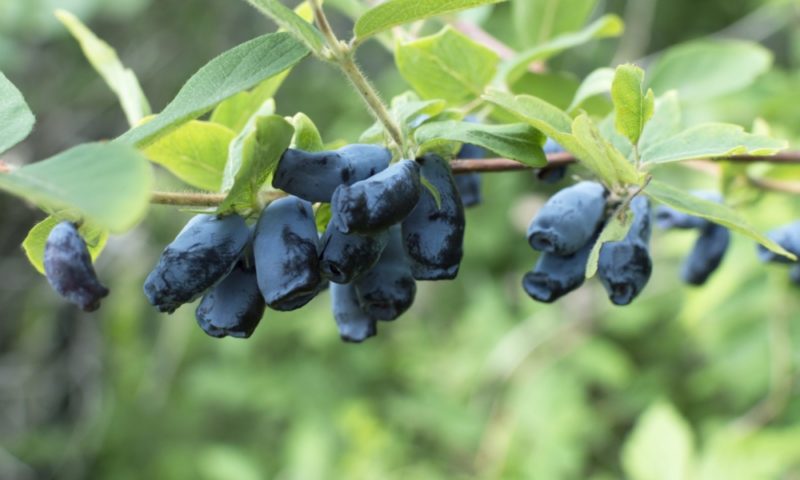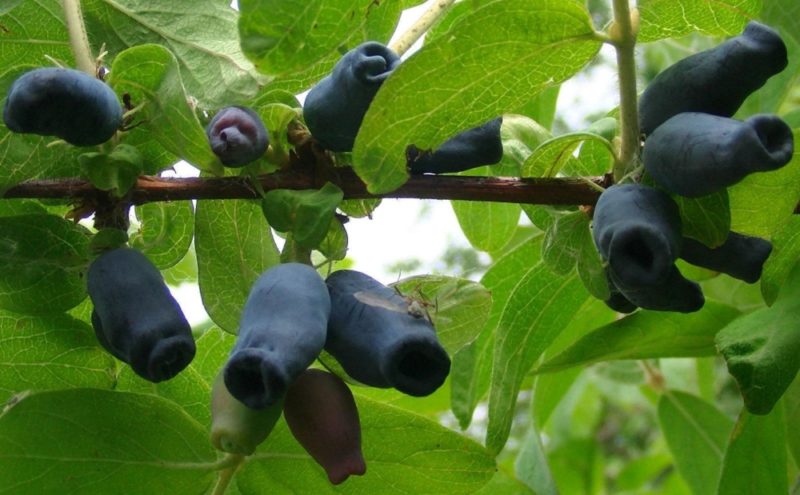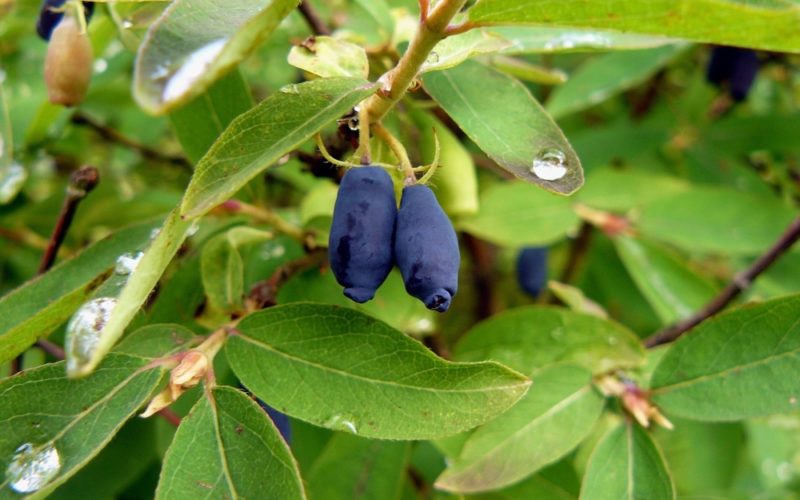Landing and caring for honeysuckle in the Moscow Region will not require much effort, but will bring a lot of positive emotions. There are about 200 different species of this plant, among them there are curly vines, deciduous and evergreen shrubs. In the article you will find a brief overview of decorative and edible honeysuckles and a description of the agricultural technology of their cultivation.
Material Content:
Description of edible and decorative varieties of honeysuckle
All decorative honeysuckles remain attractive all year round, decorating the garden. But you can’t eat fruits ripened in autumn, they are inedible.
Popular varieties:
- Honeysuckle. The culture is winding. Suitable for landscaping vertical surfaces - arbors, arches, walls, fences. It is decorative, unpretentious, frost-resistant, it has beautiful foliage and fragrant flowers.
- Hat honeysuckle. An evergreen bush with a height of about 1.3 m, grows in breadth, forming a semicircular shape. The leaves are small, bright green, fragrant flowers. Rounded purple or red fruits are inedible.
- Japanese honeysuckle. A plant with lemon yellow leaves in a green speck, the height of the bush is about a meter. To preserve the decorative color planted in a well-lit place.
- Golden honeysuckle. Deciduous shrub with leaves up to 12 cm long. Creamy small flowers have a faint aroma, red berries ripening in September are very beautiful.
- The honeysuckle is early flowering. A distinctive feature of this species is the early appearance of pink fragrant flowers. They bloom in April, before the leaves.
There are other species, with edible, very tasty and healthy fruits. To obtain cultural forms, breeders crossed the Honeysuckle Edible and Kamchatka.
The best varieties of honeysuckle for Moscow region:
- "Bakcharsky Giant";
- "Chosen One";
- "Sineglazka";
- "Gzhel early";
- "Cinderella";
- "Kamchadalka";
- "Moraine";
- Moskovskaya 23, etc.
The berries have a sweetish-sour, slightly tart taste, they are the first to ripen in the garden - an early harvest is collected at the beginning or end of May, depending on the region.
The fruits contain a lot of vitamins B1 and B2, which help maintain the health of the digestive, nervous and cardiovascular systems.
The maximum yield is small - about 3-4 kg from the bush. In wild, species honeysuckle, the berries are small. In large-fruited cultivars, they can be from 3 to 5 cm in length. The crop is poorly transported, so it is better to process it right away - eat the fruits raw, grind them into jams, jams, prepare wines, dry, freeze.
How and when to plant a bush
One of the first in the garden to produce leaves edible honeysuckle, at the same time it shows buds and flowers. On the street at this time it is still very cold. When the honeysuckle is blooming, there are no insects yet, it is pollinated by the wind, so the bushes should be planted in a group of 3-5 plants, not far from each other.
Plant height depends on the variety. Hedges can be formed from bushes, breaking the site into zones. Then the benefits of the culture will be double - a delicious harvest and decoration of the garden.
Soil requirements, site selection
Under natural conditions, honeysuckle grows in the forest. In the garden, the plant feels better under the shadow of the crown of trees, where there is no strong shading. Planting time depends on the species. So, decorative species characterized by a late growing season can be planted in the off-season. Varieties with edible fruits that already bloom in April and have early ripening, it is advisable to plant in late summer or early fall.
Shrubs need to provide fertile soil. Suitable neutral and slightly alkaline substrate (optimal acidity of 7.5 - 8.5).
The hole is prepared about 0.3 m deep and of the same diameter. It is filled with a fertile mixture. Not suitable for growing heavy, damp and poor, sandy soil.
Landing of a honeysuckle in Moscow suburbs
In the nursery choose healthy seedlings, well developed, but not old (height from 0.3 m). It is necessary to plant copies belonging to different varieties in the garden in order to get a rich harvest. Honeysuckle is a cross-pollinated culture; breeders have not yet bred self-fertile varieties.
- When placed with a perspective on a hedge, between the bushes leave a space of about 1.5 m. For the formation of decorative compositions, the interval between holes can be increased to 3 m.
- Wells are prepared in advance, filling with a composition of compost, garden soil and fertilizers (100 g of superphosphate and 1 tbsp of ash).
- By placing a seedling in the hole, make sure that the root neck is located at ground level.
- The roots are straightened, sprinkled with soil on top, slightly compacted with a hand so that there are no voids, and watered abundantly.
- It is desirable to close the trunk circle with any mulching material to preserve moisture in the ground.
Outdoor Care
Decorative honeysuckle likes regular watering, as it has a superficial root system. Especially important is the moistening of the soil during flowering and berry filling in edible varieties. After irrigation, the near-stem circle is loosened and the weeds removed.
For fruiting, edible varieties need fertilizer.
You can feed plants with Kemira Universal (in early spring) and infusion of manure. Fertilizers are introduced until mid-July. Since the second half of summer, edible honeysuckle is preparing for winter rest, and it does not need nitrogen fertilizers. In the second year of cultivation, manure is not introduced. In the future, it is used for feeding only 1 time in 3 years.
The first 3 years the honeysuckle is not pruned.Then, every fall or spring (in March), sanitary pruning is performed, removing diseased shoots. Formative pruning of adult bushes is also necessary, since fruiting is reduced due to the dense crown. The tops of the blue honeysuckle shoots are not recommended to be cut off, since there are a lot of flower buds on them.
The honeysuckle is frost-resistant, and even during flowering it can withstand frosts down to -8 ° C. For the winter it does not need to be covered.
Honeysuckle breeding
The plant grows rapidly, it is easy to propagate by cuttings.
- At the end of May or June, young growths of the current year can be broken off with a heel (a piece of bark) from last year's branch.
- It is enough to stick the resulting cuttings into the ground.
- In this case, the lower leaf plates must be cut off, and the upper ones should be slightly shortened to reduce the area of moisture evaporation.
- Place rooting cuttings in a shady, humid place in the garden.
In garden centers, edible honeysuckle seedlings need to be bought in the fall, because no one sells it in April. It fades at this time and sets the fruits. Decorative varieties with a closed root system can be planted throughout the warm season.
Features of care after fruiting
Honeysuckle begins to ripen before strawberries. It continues to bloom when the first berries are planted, and gives the whole crop back only after 1.5 - 2 months. Most varieties of edible honeysuckle do not hold ripe fruits, they immediately crumble, so it is important to collect them regularly. There are pleasant exceptions - varieties that hold ripe berries for a long time (Moskovskaya 23).
Care after fruiting consists of regular watering, loosening the soil and pest control, if they have chosen plants.
In mid-June, cuttings are cut to obtain seedlings. In July or August, you can give phosphorus-potassium fertilizing, so that the honeysuckle is better prepared for the winter.
Diseases, pests and methods of dealing with them
Proper cultivation of honeysuckle makes it resistant to disease.
Weakened plants can be attacked by various pests:
- Honeysuckle aphids parasitize on a shrub. Sick leaves turn yellow, curl, and begin to dry out. The growth of young shoots stops, the berries are smaller, the yield is reduced.
- The parasite of the scabbard sticks firmly into the bark of the shoots, sucking their juice. Mass infection can lead to the death of plants.
- The pulp of berries and seeds is a delicacy of the fingerworm caterpillar. The pest contributes to the early shedding of fruits, loss of crop.
- Attack honeysuckle and some types of ticks. They cause premature falling of leaves, are carriers of fungal diseases.
After completing the harvest, it is advisable to treat the bushes with chemicals - IntaVir, Aktara, Aktellik (from ticks).
During fruiting, insecticides cannot be used. To combat pests, folk methods are used - infusion of potato or tomato tops.
The development of fungal diseases contributes to increased humidity and thickened plantings. For prophylaxis, the bushes are treated in early spring with a solution of Fundazole or copper sulfate.
On a site it is worth planting a honeysuckle. This unpretentious plant will delight you with beautiful fragrant flowering and a delicious harvest with minimal care.

















